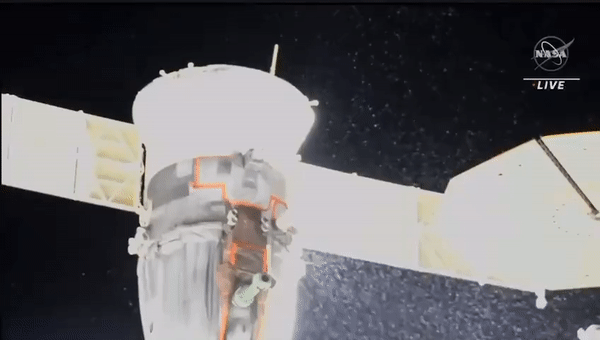Rescue Soyuz spacecraft can't reach International Space Station until February
Russia and NASA are still evaluating whether a leaky Soyuz spacecraft is safe to return three International Space Station crew members home.

It will be a while before backup comes for a space station crew currently depending on a leaky Soyuz to get home.
Should the Soyuz MS-22 spacecraft be deemed unsafe after spouting coolant into space Dec. 14, two cosmonauts and a NASA astronaut will need to wait until February for a backup Soyuz to arrive at the International Space Station (ISS), a Russian space official said during a press conference Thursday (Dec. 22).
"Our next crew ... was scheduled to fly in the middle of March," said Sergei Krikalev, head of the Yuri Gagarin Cosmonaut Training Center near Moscow, during the livestreamed NASA press conference.
The new Soyuz on the ground planned for that crew could instead be launched empty to retrieve the three ISS crew members if they are indeed stranded. But Krikalev said it can only be "sent up a little earlier ... about two, three weeks earlier is at the maximum what we can do at this point."
In photos: International Space Station at 20
The cause of the hole that caused the leak is still under investigation, but one idea has been ruled out: it was not part of the ongoing Geminid meteor shower, as the trajectory was in the wrong direction, Joel Montalbano, NASA's ISS program manager, said during the same briefing.
On Sunday (Dec. 18), NASA worked with cameras on the station's Canadarm2 robotic arm. The survey found a small hole in the MS-22 that is the likely cause of the leak, but how the hole came to be isn't yet known.
Breaking space news, the latest updates on rocket launches, skywatching events and more!
"We got some work to do with imagery to better understand if it was a meteoroid hit or if there was a hardware issue, and that work is in front of us," Montalbano said. Another possibility is a piece of space junk, but Krikalev said such an object would be too small to track from the ground as the hole was only 0.8 millimeters wide.
If Russia indeed fast-tracks the next Soyuz to the space station, the damaged MS-22 would come back empty. "Roscosmos would plan to return the current Soyuz on orbit and collect the data so they can use that for future evaluations," Montalbano said.
Elizabeth Howell is the co-author of "Why Am I Taller?" (ECW Press, 2022; with Canadian astronaut Dave Williams), a book about space medicine. Follow her on Twitter @howellspace. Follow us on Twitter @Spacedotcom or Facebook.

Elizabeth Howell (she/her), Ph.D., was a staff writer in the spaceflight channel between 2022 and 2024 specializing in Canadian space news. She was contributing writer for Space.com for 10 years from 2012 to 2024. Elizabeth's reporting includes multiple exclusives with the White House, leading world coverage about a lost-and-found space tomato on the International Space Station, witnessing five human spaceflight launches on two continents, flying parabolic, working inside a spacesuit, and participating in a simulated Mars mission. Her latest book, "Why Am I Taller?" (ECW Press, 2022) is co-written with astronaut Dave Williams.
